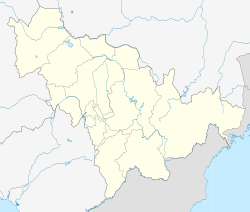Baicheng
|
Baicheng 白城市 |
|
|---|---|
| Prefecture-level city | |

Dust storm comes to Baicheng in 2001
|
|
 Baicheng (red) in Jilin (orange) |
|
| Location of the city centre in Jilin | |
| Coordinates: 45°37′N 122°50′E / 45.617°N 122.833°ECoordinates: 45°37′N 122°50′E / 45.617°N 122.833°E | |
| Country | People's Republic of China |
| Province | Jilin |
| Incorporated (town) | 1915 |
| Incorporated (city) | 1958 |
| City seat | Taobei District |
| County-level divisions | 5 |
| Government | |
| • Type | Prefecture-level city |
| • CPC Baicheng Secretary | Li Jinxiu (李晋修) |
| • Mayor | An Guiwu (安桂武) |
| Area | |
| • Total | 25,683 km2 (9,916 sq mi) |
| Elevation | 154 m (505 ft) |
| Population (2010) | |
| • Total | 2,033,058 |
| • Density | 79/km2 (210/sq mi) |
| Time zone | China Standard (UTC+8) |
| Postal code | 137000 |
| Area code(s) | 0436 |
| Licence plates | 吉G |
| ISO 3166-2 | cn-22-08 |
| Website | http://www.bc.jl.gov.cn/ |
Baicheng (Chinese: 白城; pinyin: Báichéng; literally: "White City") is a prefecture-level city in the northwestern part of Jilin province, People's Republic of China, bordering Inner Mongolia to the north and west and Heilongjiang to the east and northeast. At the 2010 census, 2,033,058 people resided within its administrative area of 25,683 km2 (9,916 sq mi).
The area around present day Baicheng was a nomadic area which was inhabited by several nomad tribes in Northeast China as early as the Late Neolithic Age, including the Eastern Hu, the Xianbei, the Fuyu, and the Khitans once inhabited the area. During the Liao Dynasty, Baicheng was the political center of four emperors, including Emperor Shengzong, Emperor Xingzong, Emperor Daozong, and Emperor Tianzuo, as the seat of the local government was located at Chengsijiazi Ancient fort in today's Taobei District. As Qing Government forsook the settlement of Han Chinese in the 19th century, no farming was allowed until 1902. In 1904 Baicheng became a county going by the name of Jing'an (靖安). In 1914 Jing'an County was renamed Tao'an (洮南). By 1938 it was finally renamed Baicheng, which in Chinese means white town. The name's origin is the Mongolian name of the city Chaghanhot, which also means "white town". Baicheng used to belong to Nenjiang and Heilongjiang province, under the jurisdiction of the former provincial capital Qiqihar. In 1954, with the Heilongjiang Province merged with Songjiang Province, Baicheng was incorporated into Jilin Province.
Baicheng's importance started to increase after a railway from Qiqihar to Siping through Baicheng was constructed in the 1920s. In the 1930s another railway connecting Baicheng to Ulanhot and the mines at Arxan was opened northwestward. These two lines enabled Baicheng to become a regional transportation hub in western Jilin Province. One more rail line connecting Changchun was opened in the mid-1930s as well.
...
Wikipedia

